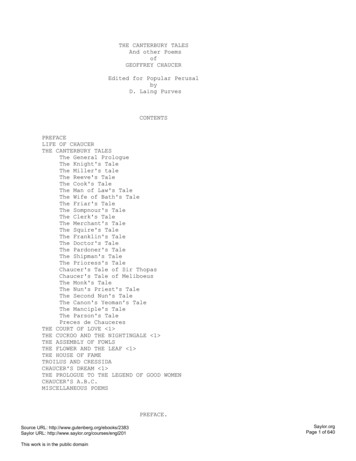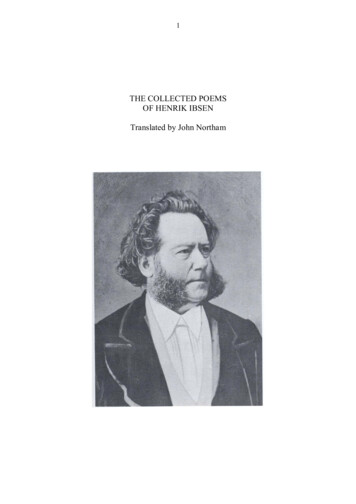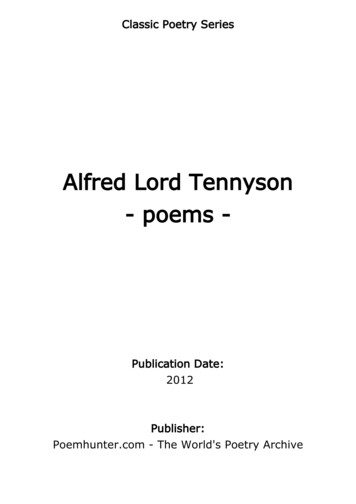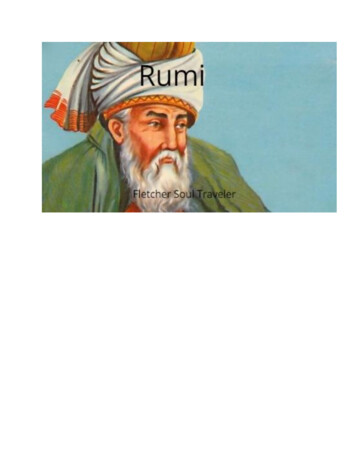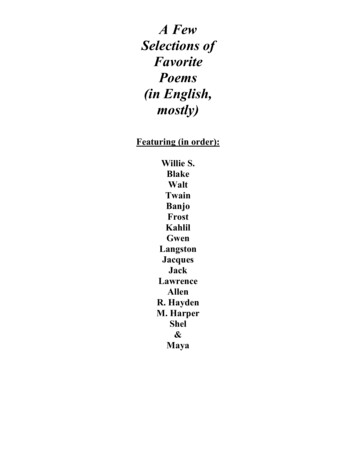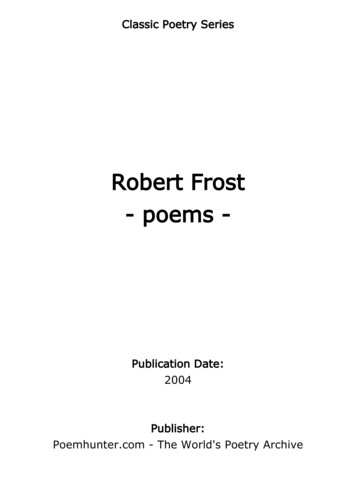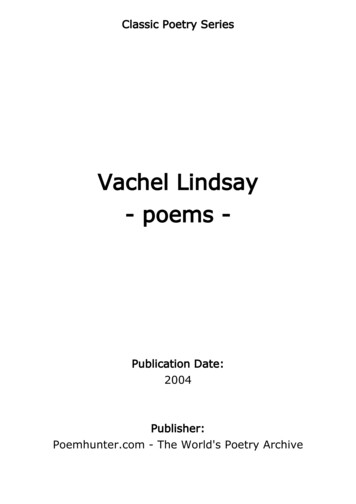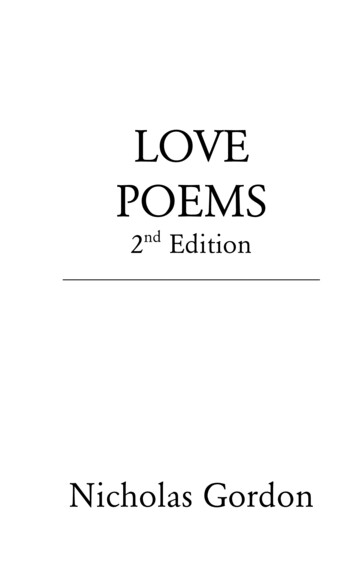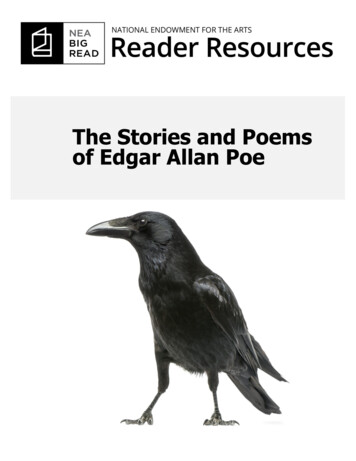
Transcription
The Stories and Poemsof Edgar Allan Poe1
Table of ContentsThe Storiesand Poems ofEdgar Allan PoeAbout the Book. 3About the Author . 5Historical and Literary Context . 7Other Works/Adaptations . 8Discussion Questions. 9Additional Resources . 10Credits . 11“I would give theworld to embodyone half the ideasafloat in myimagination.”PrefaceEdgar Allan Poe invented the detective story, perfected thehorror tale, and first articulated the theory of the modernshort story as well as the idea of pure poetry. A hero ofDostoevsky, Baudelaire, and Nabokov, Poe has never beenentirely respectable to American critics because of his twin“faults”: being too eccentric, and too popular amongcommon readers.It’s time to say the obvious. No author stays internationallypopular for 150 years by accident. Poe is one of the classicauthors of American literature—a master of the short story,a magician of the short poem, and a critic of brilliance andoriginality. And no small part of his artistic sleight of hand isthat he appeals to readers from childhood to old age. Let usunderestimate him nevermore!NEA Big ReadThe National Endowment for the ArtsWhat is the NEA Big Read?A program of the National Endowment for the Arts, NEA BigRead broadens our understanding of our world, ourcommunities, and ourselves through the joy of sharing agood book. Managed by Arts Midwest, this initiative offersgrants to support innovative community reading programsdesigned around a single book.A great book combines enrichment with enchantment. Itawakens our imagination and enlarges our humanity. It canoffer harrowing insights that somehow console and comfortus. Whether you’re a regular reader already or making upfor lost time, thank you for joining the NEA Big Read.2
About the BookIntroduction tothe BookFew writers have pioneered somany forms of escapism asEdgar Allan Poe, and fewer stillhave sought escape sodesperately themselves. Poe’sclaustrophobic life consisted ofone escape attempt afteranother, most of themunsuccessful. Again and againhe dodged poverty throughoverwork, but never for long.He fled loneliness into an illfated, loving but likely chastemarriage to a frail cousin. And drink promised an oblivionthat kept luring him back, with increasingly destructiveconsequences.Poe’s most satisfying escape was into his writing, wheregenerations of readers have followed him ever since. Hissheer versatility continues to astonish. Without Poe, theliterary arts of horror, adventure, detective, and sciencefiction—and, arguably, the short story itself—would havedeveloped very differently. In addition to fiction in severalgenres, he wrote as famous a poem as American literaturecan claim. He practiced literary criticism as fine art, bloodsport, and, with a series of female poets, the highest form offlirtation. If the movies had existed in the nineteenthcentury, he might have written screenplays as well—andbedeviled his producers as reliably as he did most of hiseditors.At the same time, another side of Poe remained relentlesslylogical. In his criticism as well as his detective stories, hecould make a case and prove it with mathematicalinevitability. Often lost in any study of Poe, too, is his senseof humor. Though their victims would hardly have agreed,his hoaxes, essays, and especially his negative reviewsretain their wit even today. Even the most macabre of hisstories impart a certain ghoulish tickle.Poe’s influence is almost too universal to notice. Heresembles scarcely anybody before him but, at least a little,almost everyone after. If he hadn’t come along to makeAmerican literature safe for ghosts and murderers, for crimesolving know-it-alls and their quarry—for the subconsciousmind, in all its murk and madness—somebody else mighthave. But, to use one of Poe’s signature italicized endings,what if nobody had?Poe’s FictionThroughout Poe’s fiction, there runs an undercurrent ofinwardness, an obsession with dark corners of thesubconscious mind, at the time familiar perhaps only fromMary Shelley’s Frankenstein (1818). He also used a fictionwriter’s entire bag of tricks—exclamation points, doubledashes, italics, repetition, the capitalization of first lettersand sometimes of entire words—to pump up the urgency ofhis gothic stories. If melodramatic organ chords could talk,they would sound like the narrator of a Poe story.Few students of Poe can resist the temptation to group hisstories into subsets, like teams. Some might say there’s theclaustrophobia team, captained by the “The Cask ofAmontillado,” in which the narrator bricks up his friend in awine cellar. Then there’s the idealized-women team,anchored by “Ligeia” and “The Fall of the House of Usher,”with its female characters either doomed, impossibly perfect,or both. Then there’s the junior detective team, consistingmainly of “The Murders in the Rue Morgue” and its twosequels, in which Poe essentially invented detective fiction.What these categories all have in common is the selfdramatizing loneliness of genius. Poe almost always relies ona first-person narrator. All his stories are ultimatelyclaustrophobia stories, whether they include a literallyconfined space, a roomier but still airless and solitary house,or the psychological prison of a damaged character’s mind.Poe’s treatment of women characters also reflects hisessential solitude. Many of his narrators marry, but noneever achieves a lasting connection with his bride. Even hismost self-satisfied character, the peerless amateur detectiveC. Auguste Dupin, has but one friend and no equal. We don’tsee the suffering this causes, but only the shallowestcharacter would fail to feel it.No serious writer today could get away with all thishyperventilating. Yet few writers can fully escapePoe’s gravitational pull as one of the original two masters ofthe American short story. The other would be NathanielHawthorne, who, interestingly, also wrote more than a fewhorror stories. Like many fledgling writers, American fictionitself started out with a fascination for ghosts and gore.NEA Big ReadThe National Endowment for the Arts3
Poe’s PoetryEdgar Allan Poe began his literary career as a poet, was amerciless critic, and found his greatest success with “TheRaven.” Poe defined poetry as “the rhythmical creation ofbeauty.” He had strong and serious ideas as to whatqualified as “poetry,” and what fell short.Poe wrote several variable essays on poetics—the best is“The Poetic Principle”—through which his ideas evolved, butremained fairly consistent. In “The Philosophy ofComposition,” Poe outlines how he came to write “TheRaven,” detailing his artistic choices. Scholars have pointedout that Poe’s account of writing the poem is vastly idealizedand probably untrue, but however disingenuous Poe is abouthis composition, he’s crystal clear on his philosophy: “Beautyis the sole legitimate province of the poem. Melancholy isthus the most legitimate of all poetical tones.The death,then, of a beautiful woman is, unquestionably, the mostpoetical topic in the world—and equally is it beyond doubtthat the lips best suited for such topic are those of abereaved lover.”The death of a beautiful woman is the theme that dominatesthe best of Poe’s poems. There is “the lost Lenore” of “TheRaven,” but also Lenore of the poem “Lenore”—Poe thoughtthat the sound or was the most beautiful in the Englishlanguage. His other famous poem to lost love, “Annabel Lee”tragically ends when he lies down by the side of his “life”and his “bride” “in the sepulcher there by the sea, / In hertomb by the sounding sea.”NEA Big ReadThe National Endowment for the ArtsPoe devoted his longest essay on poetics, “The Rationale ofVerse,” to an overly complicated view of rhythm and meter,but the importance of sound in Poe’s poems cannot beoverstated. A master of rhythm, Poe’s syllable-by-syllableapproach to sound yielded some of the most memorablelines in American poetry. His ear for mimicry is unparalleled.“The Bells” is an onomatopoetic marathon of tinklingtintinnabulation and clanging, banging bells, bells, bellsthroughout.Excluding “The Raven,” Poe’s poems are mostly short lyricpieces—meditations on death or beautiful women or thedeath of beautiful women—almost always less than a pagelong. He believed that a poem should be readable in onesitting and objected to what he saw as the epic “mania”among such contemporaries as Longfellow, whom he feltvalued Truth and moral didacticism over the exaltation ofBeauty.For all the time he spent writing about it, Poe left behind arather slim corpus of poetry. Perhaps because his standardswere so high, a remarkable share of Poe’s poems areexcellent in their technique and unity. His poems remainpopular in and outside the classroom, and are assured aplace in the minds of readers forevermore.4
About the AuthorEdgar Allan Poe(1809-1849)Edgar Poe was born in 1809in Boston to David andElizabeth Poe. David was theson of a Revolutionary Warhero and a drinker; Elizabeth,a popular stage actress. Soonafter Edgar’s birth, David Poeleft the family, and inDecember of 1811, Poe’smother died. Two-year-oldEdgar was taken in by JohnAllan, a wealthy Richmondtobacco merchant, who lentPoe his middle name.In 1842 Virginia ruptured a blood vessel, the first sign of theill health that plagued her short life. To cope with her illnessand the stress of his failing finances, Poe occasionally turnedto alcohol. He repented after each binge, but his employersand friends took note. In 1845, Poe published “The Raven,”which brought him temporary popular and critical acclaim.Always prone to self-destructive behavior, Poe attackedHenry Wadsworth Longfellow on grounds of plagiarism,greatly damaging his own reputation.Two years later, Virginia died of tuberculosis. Poe’s owndeath followed just two years after that. The cause of hisdeath remains uncertain.Edgar Allan Poe, 1848(Courtesy of the Poe Museum,Richmond, Virginia)Poe spent a single year at the University of Virginia. AfterJohn Allan refused to pay his second-year tuition, andgambling debts kept him from paying his own way, Poejoined the army. He did well there and, when his enlistmentwas up, attended West Point for officer training. He wassoon expelled for failing to attend class and skippingmandatory chapel services. He settled in Baltimore with hispaternal aunt Maria Clemm and her eight-year-old daughter,Virginia, Poe’s future wife.Poe became a regular contributor to the Southern LiteraryMessenger, publishing not just stories but scathing bookreviews that earned him the nickname “tomahawk man.”Poe, Virginia, and Maria Clemm moved to Richmond, wherePoe then took the reins as editor of the Messenger. The nextyear, Poe, 27, and Virginia, 13, married.Poe resigned from the Messenger in 1837 over a salarydisagreement and moved the family to New York wherefinancial troubles continued to haunt him. He met with somesuccess in 1840, when he released Tales of the Grotesqueand Arabesque, including all his stories up to that point.NEA Big ReadThe National Endowment for the ArtsThe Death of Edgar Allan PoeOn October 3, 1849, Poe was found at Ryan’s 4th WardPolls, a tavern also known as Gunner’s Hall, in Baltimore,disoriented and wearing tattered clothing. He was admittedto Washington College Hospital, where he never regainedfull consciousness and died four days later.His death was attributed to “congestion of the brain,”though no autopsy was performed. Due to conflictingtestimonies from his doctor and a libelous obituary writtenby his literary nemesis Rufus Griswold, the nature of Poe’sdeath has remained in question. Doctors and scholars havetheorized that Poe died of epilepsy, hypoglycemia, beating,rabies, alcohol, heart failure, murder, or carbon monoxidepoisoning. One of the most compelling scenarios is that Poe,found on election day, was a victim of “cooping,” a form ofvoter fraud in which a person is dressed up, beaten,drugged, and forced to vote multiple times—the term isrelated to a “chicken coop,” as victims were often heldcaptive in a small space while abused. Not one of thesetheories has been proven, and Poe’s death remains amystery.5
Poe’s HousesPoe the CriticThe Poe MuseumRichmond, VirginiaIn his day, Poe was known for his poison pen, but a fewcontemporaries did earn his admiration.Poe was raised in Richmond by the Allan family. He movedback in 1835 to work for the Southern Literary Messenger.Most of the landmarks and houses from Poe’s time inRichmond have been lost to history, but Richmond’s PoeMuseum offers a collection of his manuscripts and artifacts.www.poemuseum.org Nathaniel Hawthorne, American novelist(1804-1864) Elizabeth Barrett Browning, English poet(1806-1861) Alfred, Lord Tennyson, English poet(1809-1892) Charles Dickens, English novelist(1812-1870)The Baltimore Poe House and MuseumBaltimore, MarylandPoe moved to Baltimore to live with his future wife, Virginia,and her mother. There Poe published poems and shortstories and won his first literary contest, with “Ms. Found ina Bottle.” He lived at what is now the Baltimore Poe Houseand Museum from about 1831 to 1835.www.eapoe.orgEdgar Allan Poe National Historic SitePhiladelphia, PennsylvaniaPoe lived in Philadelphia for six years, where he wrote andpublished some of his most influential work, including “TheMurders in the Rue Morgue” and “The Gold-Bug.” For thelast year or so of his time in the city (c. 1842–1844), helived with his wife and mother-in-law at what is now theEdgar Allan Poe National Historic Site, maintained by theNational Park Service.http://www.nps.gov/edal/The Edgar Allan Poe CottageFordham, Bronx, New YorkFrom 1846 to 1849, Edgar Allan Poe lived in the hills of theBronx, New York. Here, his young wife died and Poe wrotesome of his most lyrical work, such as “Annabel Lee” and“The Bells.” The Edgar Allan Poe Cottage is now preservedby The Bronx County Historical htmlNEA Big ReadThe National Endowment for the Arts James Russell Lowell, American poet(1819-1891)Poe’s Admirers“Your ‘Raven’ has produced a sensation, a ‘fit horror,’ here inEngland. Some of my friends are taken by the fear of it andsome by the music. I hear of persons haunted by the‘Nevermore,’ and one acquaintance of mine who has themisfortune of possessing a ‘Bust of Pallas’ never can bear tolook at it in the twilight.”—Elizabeth Barrett Browning“You might call him ‘the leader of the Cult of the Unusual.’”—Jules Verne“Where was the detective story until Poe breathed thebreath of life into it?”—Sir Arthur Conan Doyle“It would also be just to say that Poe sacrificed his life to hiswork, his human destiny to immortality.”—Jorge Luis Borges“It’s because I liked Edgar Allan Poe’s stories so much that Ibegan to make suspense films.”—Alfred Hitchcock6
Historical and Literary ContextThe Life and Timesof Edgar Allan Poe1800s 1801: Alexander Hamilton founds the New YorkEvening Post, heralding a decade in which the numberof U.S. newspapers roughly doubles. 1803: With the Louisiana Purchase, ThomasJefferson’s administration buys from France all or partof what will become fifteen states.1830s 1836: Poe marries his cousin, Virginia Clemm. 1837: A tightening of foreign credit, which had helpedfinance American projects including the Erie Canal,creates a financial panic and leads to a five-yeardepression. 1838: Poe’s only novel, The Narrative of ArthurGordon Pym of Nantucket, is published.1840s 1809: Edgar Poe born in Boston, January 19. 1845: Poe finds success but not solvency with “TheRaven.” 1809: Abraham Lincoln born less than a month later,on February 12. 1847: Virginia dies from complications of tuberculosis,leaving Poe even more desolate.1810s 1849: Poe dies under mysterious circumstances inBaltimore on October 7. 1811: Abandoned by her husband, Poe’s mother dies. 1815: Napoleon’s France is defeated at Waterloo. 1815–1820: Poe lives with the family of his guardian,John Allan, in Great Britain. 1819: Jefferson founds the University of Virginia1820s 1825: The Erie Canal is completed, opening the GreatLakes to seagoing Atlantic commerce for the firsttime. 1826: American Temperance Society founded. 1827: Poe publishes his first volume of poetry andjoins the Army.NEA Big ReadThe National Endowment for the Arts7
Other Works/AdaptationsPoe’s Long ShadowPoe has influenced generations of successful detective,horror, and psychological novelists, and sometimes lesssuccessful adaptors of his own work. Such horror novelistsas H.P. Lovecraft and Stephen King owe a freely confesseddebt to him, and Fyodor Dostoevsky and Sir Arthur ConanDoyle have likewise noted the enormous effect of his workon their own. French writers in particular haveacknowledged Poe’s example, and the poet CharlesBaudelaire remains one of his earliest champions and finesttranslators.the oddest stab at setting Poe to music hasbeen POEtry (2000), a theater piece and song cycle ofselected Poe work by Lou Reed and Robert Wilson, whichlater became a Reed album called The Raven (2003).The stage, too, has taken frequent advantage of Poe’sinherent theatricality. Some of these versions have evenflourished for a season or more. In the end, though,whether on stage or screen, it’s difficult to make Poe anymore dramatic than he already is.Works by Edgar Allan PoeAs with even the best translations of Poe into otherlanguages, his translations into other media may always fallshort of the original. But even the weakest of Poeadaptations have the virtue of driving us back to theoriginals, and artists who in good faith continue to plunderhim for material—unlike most of his characters—need feelno guilt. Poe’s short but always visual stories pose particularopportunities and challenges for the unwary adaptor. Yet anadmirer can easily put together a midnight, or even an allnight, film festival that does Poe credit, if never quite justice. Tamerlane, and Other Poems, 1827Two film versions of “The Fall of the House of Usher” maystand in for as many as 200 attempts so far to translate theauthor’s work. Remarkably, both “Ushers” have made theLibrary of Congress’s annual National Film Registry of moviesworthy of preservation. A product of the promising yet sadlystillborn Rochester, New York, film industry, the 1928version holds up well for its striking avant-garde approachand inventive look. The Prose Romances of Edgar A. Poe, 1843 Al Aaraaf, Tamerlane and Minor Poems, 1829 Poems, 1831 The Narrative of Arthur Gordon Pym ofNantucket, 1838 Tales of the Grotesque and Arabesque, 1840 Tales, 1845 The Raven and Other Poems, 1845More famously, Roger Corman and RichardMatheson’s House of Usher (1960), starring Vincent Price,started a vogue for Poe that indirectly led to the secondgolden age of Hollywood. Corman was a journeyman Bmovie director-producer when he discovered in Poe theperfect opportunity to combine cheesecake with purecheese. He hired mellifluous classical ham Vincent Price andgreat pulp writer Richard Matheson (The IncredibleShrinking Man (1957), Duel (1971), “The Twilight Zone”)and their several resulting Poe adaptations brought out thebest in all three. The money made in the process laterallowed Corman to bankroll low-budget first films by FrancisFord Coppola, Martin Scorsese, and many of the otherfilmmakers who ushered in the American film renaissance ofthe 1970s.Many musical works interpret Poe’s poetry and fiction. Theseadaptations include a choral symphony of The Bells bySergei Rachmaninoff (1913, rev. 1936), and two operasbased on “The Fall of the House of Usher”: one finished, byPhilip Glass (1987), one not, by Claude Debussy. PerhapsNEA Big ReadThe National Endowment for the Arts8
Discussion Questions1.Do the narrators from “The Black Cat” and “TheCask of Amontillado” deserve what they get? Do thecharacters around them? What might this say aboutPoe’s view of the world?2.In “The Fall of the House of Usher,” why does Poespend nearly two full pages on the lyrics to “TheHaunted Palace,” one of Roderick’s “performances?”Do Poe’s language and content change from oneform to the other, or just the medium?3.In “The Pit and the Pendulum,” how does thenarrator’s clever idea of smearing food on the strapsholding him down, so as to induce the hungry ratsto chew him loose, anticipate the climacticmaneuvers of heroes in suspense and actionadventure stories today?4.“The Masque of the Red Death” was originallypublished as “The Mask of the Red Death.” What isa “masque,” and do you think the pun wasintentional?5.Are the narrators of “The Tell-Tale Heart” and“William Wilson” sane? Do you like the stories betterif they’re hallucinating, or if they aren’t? Why?6.Read Poe’s essay “Philosophy of Composition,” inwhich he details how he came to write “The Raven.”Do you believe him? Why or why not?7.Listen closely to the sounds of Poe’s poems“Annabel Lee” and “The Raven.” How does his useof sound influence your reading of the poems?8.Poe’s works are haunted by death. Sometimes evenhis speakers are dead. How does this affect thetone of his work? Does it add suspense or takeaway from it?9.Poe often writes about the death of a beautifulwoman. His own wife was ill for most of theirmarriage and died at a young age. How might thisaffect the emotional intensity of his writing?NEA Big ReadThe National Endowment for the Arts9
Additional ResourcesWorks about Poe Hutchisson, James M. Poe. Jackson, MS: UniversityPress of Mississippi, 2005. Ostrom, John Ward, ed. The Collected Letters ofEdgar Allan Poe, 2 vols., 3rd ed. Revised andexpanded by Burton R. Pollin and Jeffrey A. Savoye.New York: Gordian Press, 2008. Quinn, Arthur Hobson. Edgar Allan Poe: A CriticalBiography. 1941. Baltimore, MD: The Johns HopkinsUniversity Press, 1998. Symons, Julian. The Tell-Tale Heart: The Life andWorks of Edgar Allan Poe. New York: Harper & Row,1978.Websites The Edgar Allan Poe Society of BaltimoreFounded in 1923, the Edgar Allan Poe Society ofBaltimore grew out of several smaller organizationsendeavoring to erect a memorial to Poe at hisgravesite. They have been responsible for thepreservation of Poe’s Baltimore home and continueto honor Poe’s legacy with an annual lecture seriesand several publications. The society’scomprehensive website features information andessays about Poe’s life and work.http://www.eapoe.org/ Robert Louis Stevenson’s Strange Case of Dr. Jekylland Mr. Hyde, 1886 Flannery O’Connor’s Wise Blood, 1952The Poe MuseumRichmond’s Poe Museum hosts a collection of Poe’smanuscripts and artifacts from his life. Themuseum’s website features a brief biography of Poewith special attention paid to his time in Richmond,educational resources, and a selection of Poe’sstories and poems. Shirley Jackson’s The Haunting of Hill House, 1959https://www.poemuseum.org/ Stephen King’s The Shining, 1977If you’d like to read more hauntingfiction, you might enjoy:If you’d like to read more detectivefiction, you might enjoy: Wilkie Collins’s The Woman in White, 1860 Sir Arthur Conan Doyle’s The Complete SherlockHolmes, 1930 Dashiell Hammett’s The Maltese Falcon, 1930 Agatha Christie’s Murder on the OrientExpress, 1934NEA Big ReadThe National Endowment for the Arts10
CreditsWorks CitedPoe, Edgar Allan. Complete Tales & Poems. New York:Vintage Books, 1975.---. The Portable Edgar Allan Poe. New York: PenguinClassics, 2006.Works ConsultedHecker, William F. ed. Private Perry and Mister Poe: TheWest Point Poems, 1831. Baton Rouge, LA: Louisiana StateUniversity Press, 2005.The National Endowment for the Arts was established byCongress in 1965 as an independent agency of the federalgovernment. To date, the NEA has awarded more than 5billion to support artistic excellence, creativity, andinnovation for the benefit of individuals and communities.The NEA extends its work through partnerships with statearts agencies, local leaders, other federal agencies, and thephilanthropic sector.Poe, Edgar Allan. Poetry and Tales. New York: Library ofAmerica, 1984.Quinn, Arthur Hobson. Edgar Allan Poe: A Critical Biography.1941. Baltimore, MD: The Johns Hopkins University Press,1998.Symons, Julian. The Tell-Tale Heart: The Life and Works ofEdgar Allan Poe. New York: Harper & Row, 1978.Wilbur, Richard. “Edgar Allan Poe” and “The Poe MysteryCase.” Responses: Prose Pieces, 1953-1976. New York:Harcourt Brace Jovanovich, 1976.AcknowledgmentsArts Midwest promotes creativity, nurtures culturalleadership, and engages people in meaningful artsexperiences, bringing vitality to Midwest communities andenriching people’s lives. Based in Minneapolis, Arts Midwestconnects the arts to audiences throughout the nine-stateregion of Illinois, Indiana, Iowa, Michigan, Minnesota, NorthDakota, Ohio, South Dakota, and Wisconsin. One of six nonprofit regional arts organizations in the United States, ArtsMidwest’s history spans more than 30 years.Writers: David Kipen and Dan Brady for the NationalEndowment for the ArtsCover image: "Side view of a Carrion Crow, Corvus corone,isolated on white" by Eric Isselee. Shutterstock.NEA Big Read Reader’s Guides are licensed under a Creative CommonsAttribution-NonCommercial-NoDerivatives 4.0 International License. Arts MidwestNEA Big ReadThe National Endowment for the Arts11
the best of Poe’s poems. There is “the lost Lenore” of “The Raven,” but also Lenore of the poem “Lenore”—Poe thought that the sound or was the most beautiful in the English language. His other famous poem to lost love, “Annabel Lee” tr

